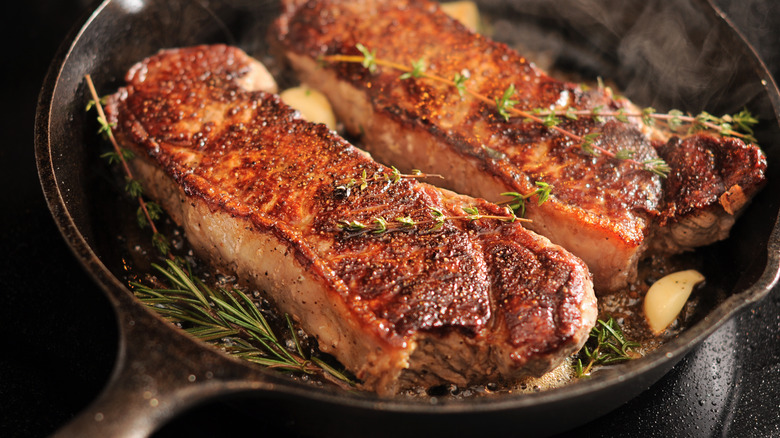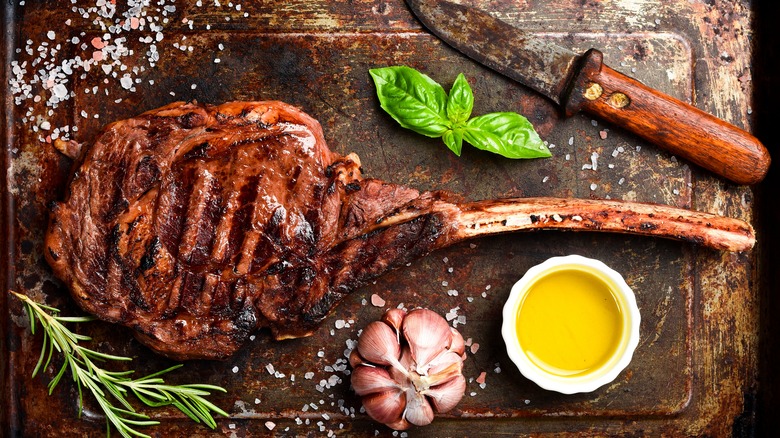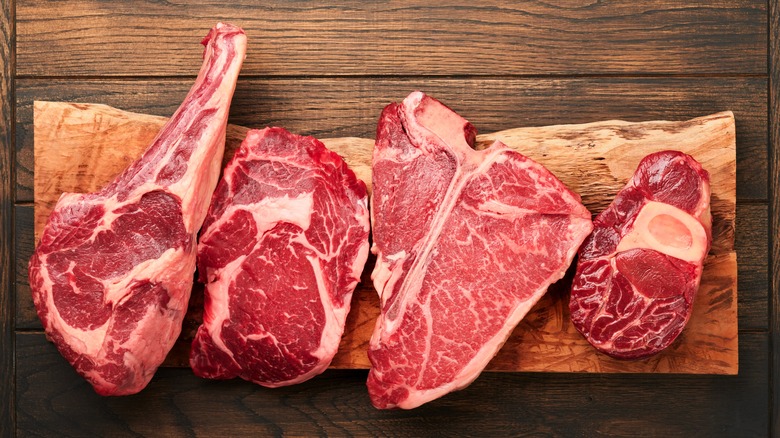The Step You Should Never Skip For More Evenly-Cooked Steaks
Steak may carry more culinary cache than any other dish. Cooking a good steak is a badge of honor — and notoriously difficult to pull off. Like any other skill, it takes practice, dedication, and know-how. If you've done your research, you've probably heard of tempering, the process of letting steak sit at room temperature before cooking it. The logic? A warmer steak reaches the right internal temperature faster than a cool one. It takes longer for the heat to reach the center of a fridge-fresh steak, so the meat can end up overcooked on the outside and undercooked on the inside.
But is tempering steak really that important? For answers, The Takeout turned to Cordon Bleu-trained chef Matthew Kreider. Steak is Kreider's specialty: He currently works as executive chef at Miami's Steak 954, a luxury steakhouse located at the W Hotel. "Tempering a steak can be a good idea," Kreider explains. "If you've ever cooked a steak, and had a thick gray band on the outside of the steak, try tempering."
That dry, unsightly gray band is a sign of overcooked meat — not something you want in your steak. "You will see that gray band get much smaller," Kreider notes. "The temperature of the steak will not have to change as drastically."
Tempering is especially important for large steaks
Thinking about skimping on the tempering? You might get away with it for thinner cuts, but Kreider doesn't recommend skipping it for thicker ones. After all, some cuts of steak are trickier than others. "I typically temper large steak cuts," he explains. Tempering isn't the only way to bring steak up to temperature, though. "There are many different methods you can use. Some include sous vide or reverse searing."
Like sous vide and reverse searing, tempering lets you use high heat, which is key to a good steak. High heat gives the meat a crispy crust, but it comes with the risk of an undercooked interior. But sometimes it's hard to find the balance — especially with thicker cuts of steak, which typically need lower heat.
"I believe high heat is typically the ideal for a great steak," says Kreider. "If you rest the steak in a warm environment it will carry the internal temperature further than you think," he added. "I am not a fan of low and slow for most cuts of beef."
How to temper steak
Okay, you're convinced. But how should you temper steaks? And isn't it dangerous to leave raw meat at room temperature?
Don't worry too much about leaving meat out — the United States Department of Agriculture states that meat can safely stay at room temperature for up to two hours. Just 20 minutes makes a difference for thin steaks, though you should err toward 20 to 40 minutes for thicker cuts. Just be smart about it: Keep steak inside, away from animals, and out of direct sunlight. And remember, room temperature is around 70 degrees Fahrenheit. If you're in a 90-degree tropical bungalow, meat will start to spoil after an hour.
Curious about sous vide and reverse searing, the other methods Kreider mentioned? While sous vide requires special equipment, reverse searing is a relatively good method to try at home. Reverse searing involves putting the steak in an oven to bring it to temperature before placing it in the pan — essentially an extra-intense version of tempering. The downside? It's easy to overcook. Unless your kitchen's temperature is a balmy 200 degrees, there's no danger of accidentally cooking your steak while you're letting it temper. Just remember to give yourself plenty of time: You'll need to let the steak rest again before serving it.


